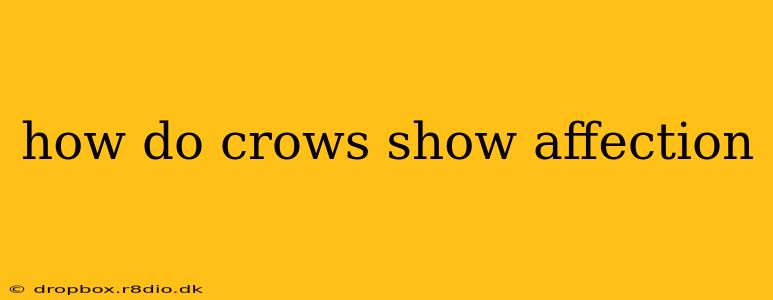Crows, often perceived as ominous figures in folklore, possess a surprisingly complex social structure and surprisingly nuanced ways of expressing affection. While they might not cuddle like house cats or shower kisses like humans, these intelligent birds demonstrate affection through a variety of fascinating behaviors. Understanding these subtle cues requires a keen observation of their interactions and an appreciation for their unique communication style.
Beyond the Caws: Unveiling Crow Affection
Forget the stereotypical image of solitary, scavenging birds. Crows are highly social creatures, forming lifelong pair bonds and complex family units. Their displays of affection, while different from human expressions, are equally powerful and meaningful.
1. Allopreening: A Sign of Deep Connection
Allopreening, the act of meticulously cleaning and grooming another crow's feathers, is a significant indicator of affection and social bonding within a crow community. This isn't just a random act; it strengthens bonds, reinforces social hierarchy, and demonstrates trust and care. Imagine the intimate connection of sharing such a personal act – a gesture of comfort and affection rarely observed outside of close relationships. By meticulously removing parasites and smoothing ruffled feathers, crows build and maintain strong social ties.
2. Food Sharing: A Generous Act of Love
Sharing food isn't just a practical behavior among crows; it’s a potent expression of affection, particularly within mated pairs and family groups. The act of offering and accepting food signifies trust, cooperation, and a willingness to share resources. This generosity extends beyond immediate family; it can be observed between close friends within the flock, highlighting the importance of social bonds in their survival and well-being.
3. Mutual Grooming Beyond Allopreening: A Symbol of Camaraderie
While allopreening focuses on feather maintenance, mutual grooming often extends to other areas, including beak cleaning and even gentle pecking. These actions, often performed between close companions, symbolize trust, intimacy, and a shared sense of comfort. This form of affectionate grooming goes beyond the basic necessities of hygiene, acting as a social glue that strengthens their social fabric.
4. Vocalizations: A Symphony of Affection
Crows possess a vast repertoire of vocalizations, and the subtle nuances of their calls can provide valuable insights into their emotional states. While certain calls might sound alarming to us, many are actually friendly greetings or soft murmurs exchanged between closely bonded individuals. These quiet exchanges, often overlooked by casual observers, speak volumes about the affection and companionship shared within the flock. Scientists are still decoding the complex language of crow vocalizations, uncovering new layers of communication and social interaction.
5. Physical Proximity and Mutual Comfort: A Quiet Demonstration
Like many social animals, crows often demonstrate affection through physical proximity and shared comfort. Close proximity within a flock isn’t random; it indicates strong social bonds and a sense of mutual security. They might roost together, huddle close during cold weather, or simply rest side-by-side, showing a preference for the company of specific individuals. These subtle cues, while less obvious than allopreening or food sharing, reveal a deep sense of attachment and affection.
Conclusion: Understanding the Crow's Heart
While crows may not express affection in ways easily understood by humans, their behavior reveals a rich tapestry of social interactions and complex emotional bonds. By observing their allopreening, food sharing, mutual grooming, vocalizations, and physical proximity, we gain a deeper appreciation for these intelligent birds and the intricate ways they express their love and affection within their sophisticated social structures. Further research continues to uncover the depths of crow communication, promising further insights into the heartwarming dynamics within their fascinating communities.

